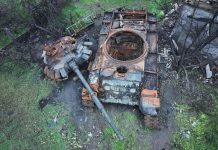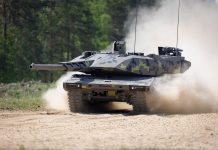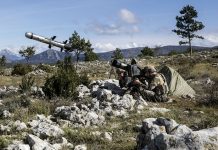On the modern battlefield, extra protection for armoured vehicles is increasingly in demand with high-performance organic armour and active protection systems comprising two vital elements. Add-on armour is a vital third element of a comprehensive protection package for armoured fighting vehicles (AFV) and armoured support vehicles.

Credit: US Army
Add-on armour has the advantage of being modular, allowing the user to configure the extra protection according to operational requirements, the known vulnerabilities of the base-armour, and the carriage capabilities of the vehicle. In some operational environments, a minimum amount of additional armour will be mounted to defend against a particular weapon threat (and minimise impact on vehicle manoeuvrability), while in other high-threat scenarios the maximum possible panoply might be applied. Commonly used materials include hardened steel, ceramic armour, and multi-component composites. Various types of add-on armour are available, providing a wide spectrum of options to the user.
Appliqué plate and spaced armour
The simplest appliqué armour consists of at least one layer of (usually hardened steel or ceramic) plates attached to the vehicle’s organic armour. A composite material absorber layer can be placed between the organic armour surface and the appliqué plate in order to absorb fragments of the warhead or plate. When two appliqué plates are positioned over one another with a space in between, the configuration is designated as spaced armour. The plates may be applied at a vertical angle to take up less volume, or at a sloped angle for enhanced protection.
These systems tend to be lighter in weight compared to other add-on options, which makes them suitable for smaller vehicles such as armoured 4×4s. Britain’s Air Sea Land Group (ASL) offers a line of appliqué solutions primarily for lighter vehicles. ASL’s Assero-A single-plate armour provides STANAG level 2-4 protection; the ceramic or steel strikeface can shatter incoming projectiles, and is coupled with a composite absorber to neutralise fragments. The modular and scalable ASSERO-M system comes in three variants offering additional degrees of protection against threats including improvised explosive devices (IEDs), RPGs and 30 mm rounds. ASSERO-M configurations can include single and multi-layered ballistic plates and boxes ranging from 20 mm to 350 mm thickness.

Credit: Composhield
Denmark’s Composhield also offers flexible options for up-armouring vehicles such as 4×4s and logistics trucks. The scalable system can provide ballistic protection up to STANAG level 5 against direct fire as well as blast and fragmentation. This includes defence against explosively formed projectiles (EFP), as well as IEDs. The ceramic-polymer composite armour plates are engineered to withstand heavier impact and energy release than traditional steel armour; this enhanced structural integrity ensures the ability of each plate to survive multiple impacts without breaking up. The firm offers customised solutions, enabling users to choose the amount and distribution of coverage.
Explosive reactive armour
Explosive reactive armour (ERA) consists of an explosive charge sandwiched between steel or ceramic armour plates. When a projectile pierces the outermost armour plate and strikes the explosive filler, the explosive detonates, forcing the two plates apart. In the case of high explosive anti-tank (HEAT) jets, the rapid movement of the plates and imparts powerful stresses onto the shaped charge jet, disrupting the jet and making it lose coherence, thereby leading to a large reduction in penetrating power.
In the case of an armour-piercing fin-stabilised discarding sabot (APFSDS) round, movement of the plates can likewise lead to massive stresses being imparted onto the projectile potentially bending or fracturing it, and additionally, the ERA can also impart a small degree of yaw onto the projectile, forcing it to strike the main armour at a slightly less-optimal angle and thereby reducing penetrating power further. However, defeating APFSDS projectiles typically requires use of heavier plates, along with a slightly greater quantity of explosive filler to effectively impart the necessary energy onto the penetrator, and many early ERA designs lacked these.
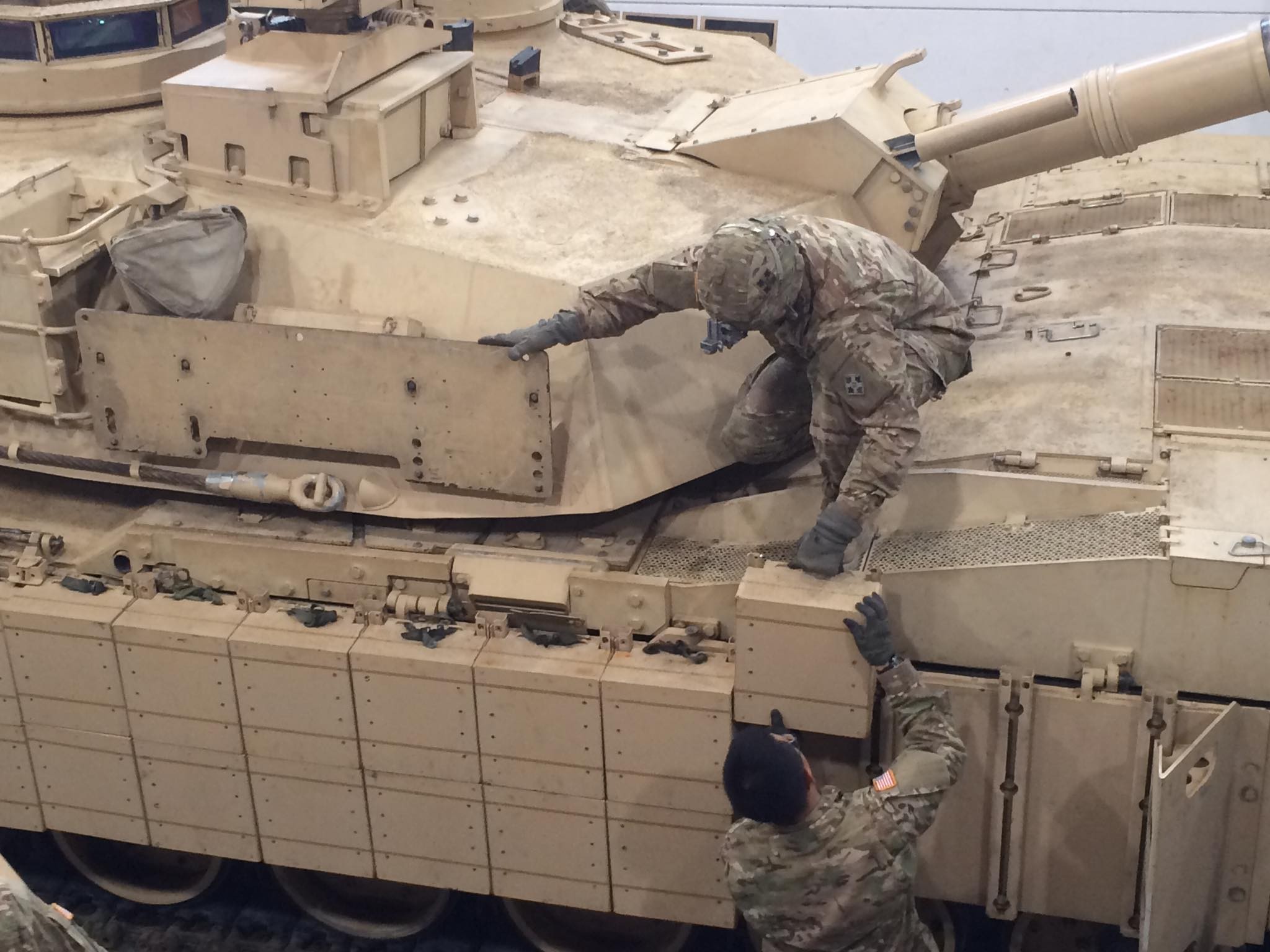
ERA is widely used as add-on protection, most commonly by Russia and former Warsaw Pact countries, as well as China, but has also seen increased adoption by western countries over recent decades. A notable western example is the US Army’s Abrams reactive armour tile (ARAT) system designed for the M1A2 Abrams main battle tank (MBT).
The US Army introduced the M19 ARAT 1 in 2006 and it is still utilised on the M1A2 Abrams. The M19 is produced for the Army by Ensign-Bickford Aerospace and Defense (EBAD). It consists of 62 flat ERA tile cassettes, each weighing 29.5 kg. The cassettes themselves consist of a layer of explosive material between two metal plates. The tiles are attached on pre-installed racks on either side of the MBT, positioned to cover the turret, hull and tracks from RPG and ATGM strikes.
In 2008, the M19 was augmented by the M32 ARAT 2 system, also developed by EBAD. The ARAT 2 is mounted over the ARAT 1 system, effectively doubling the protection. The M32 tiles are rectangular, but curve towards the centre, resembling terracotta roof tiles. This curved shape means that the faces of the tiles will always be at a slight angle in azimuth relative to any inbound projectile, which improves their capability to reduce the penetration of many common threats. Unlike the M19, the M32 ERA tiles can also be angled facing slightly downward in elevation during the mounting procedure, which further improves performance by making it less likely that a projectile could strike the plate at a perpendicular angle relative to the plate position.

Credit: US Army
The ARAT system is primarily intended to defeating shaped charge projectiles but could also be expected to degrade the penetrating capability of APFSDS projectiles at least partially. By contrast, Rafael’s Armour Shield KE system revealed in 2021, is designed specifically to be capable of defeating APFSDS penetrators, with Rafael’s tests revealing it is capable of reducing the penetrative power of an APFSDS projectile by approximately 50%. It is also capable of working against HEAT projectiles and explosively-formed penetrators (EFPs), but is less effective against tandem-HEAT warheads, which are typically used by modern anti-tank guided missiles (ATGMs). The system’s modules weigh 350–750 kg per m2 of covered surface, with turret-mounted modules being the heaviest. Armour Shield KE utilises low-explosive charges to provide a multi-hit capability, which allows a module to operate as ERA over multiple hits, rather than all of the explosive content being expended after the first hit, as is more typical for ERA.
The fact that most ERA modules can only function once is a notable disadvantage of most ERA designs, since it leaves a potential vulnerable spot for the enemy to target with repeat attacks. Moreover, modern tandem-HEAT warheads are usually designed to initiate ERA with a small initial ‘precursor’ warhead, leaving the main armour vulnerable to the primary warhead. Layering the modular armour – either with two ERA sets such as ARAT 1 and 2, or by adding a non-explosive plate or block behind the ERA – is often used to mitigate against this vulnerability.
Non-energetic reactive armour
Non-energetic reactive armour (NERA), also (alternately non-explosive reactive armour; NxRA) substitutes ERA’s explosive charge with an inert elastic substance, often a type of elastomer. As with ERA, the basic principle is to dissipate the energy of the attack to minimise the impact on the actual vehicle and preserve its base armour. As a HEAT warhead or APFSDS projectile impacts penetrates the module, it causes the elastic layer to bulge rapidly in response, pushing the two plates apart. In principle NERA operates along the same principles as ERA, albeit at lower energies, due to explosives containing more energy than an elastomer layer can provide. Unlike ERA, however, NERA modules have an inherent multi-hit capability, since there is no explosive content to be used up. This should also translates into improved performance against tandem-HEAT warheads than some ERA designs.
These advantages aside, NERA performance is widely considered less effective than ERA. Additionally, it is important to note that ERA and NERA typically do not completely neutralise the HEAT jet or APFSDS penetrator entirely – rather they typically reduce penetrative power to a level the vehicle’s passive armour is able to cope with, so a base level of armour is required to absorb any residual penetration from the projectile. For this reason, ERA and NERA are typically not used on lighter vehicles, since they often lack the required level of base passive armour.
Bar/slat/cage armour
Slat or bar armour is composed of a grid of rigid metal (usually steel or aluminium) bars mounted to protect vital or vulnerable areas of the armoured vehicle. It is sometimes referred to as ‘cage armour’, particularly when it encloses the entire vehicle. Alongside the commonly-seen aluminium and steel bars, this armour can also take the form of wire or aramid netting, and sometimes even weighted chains – although the implementation can vary, the operating principles for these armour types is the same.
Contrary to popular belief, this type of armour does not work against all shaped charge weapons. In fact, it only works against munitions which use a double-skinned nose as the conductive path for the piezoelectric fuzing system. In practice, this typically refers to the PG-7V (used by the RPG-7), PG-9V (used by the SPG-9), and PG-15V (used by the BMP-1’s 2A28 Grom launcher) families of munitions, along with their many clones and derivatives. These families of weapons have been near-ubiquitous on many battlefields around the world, and bar armour provides a simple and very cost-effective solution to reducing the threat posed by this class of munitions.

Credit: Crown Copyright
Bar armour can work to reduce the effectiveness of the aforementioned class of munitions in a number of ways. The primary design intent is that due to the warhead being wider than the bars, the two ‘skins’ of the warhead are forced together when the projectile passes between the bars. However, both ‘skins’ are conductive, and so when they are forced together, they form a short circuit, thereby preventing the electrical detonation signal from the front fuze component (assuming it has functioned as intended) from reaching the rear fuze component.
The above represents a ‘best case’ scenario, and in reality the battlefield is a messy and often chaotic place. As such, there are various other means by which bar armour can hinder the aforementioned class of munitions from functioning properly. One possibility is that the shaped charge liner is deformed upon impact, thereby preventing optimal jet formation if it does detonate, which in turn results in reduced penetration. Another phenomenon which can occur is impact-induced deflagration of the explosive charge, which can prevent or hinder jet formation. There are also some rare occasions where the projectile has been reported to have been caught by the bars and remained stuck in place, unexploded, as the target vehicle continued with its day. However, if the crew are unlucky enough for the projectile to impact a solid surface first instead of passing between the bars, for instance striking one of the bars or the frame, then this form of protection will not work as intended, and the warhead can be expected to detonate normally.
Among bar armour’s advantages, is that it can be mounted on almost any size vehicle including HMMWVs. While its weight can be detrimental to some smaller vehicles, it is lighter than other add-on armour options; for larger or heavier vehicles, this makes it a viable adjunct in addition to other appliqués, maximising protection in high-threat environments. It is also considerably cheaper than most other protective systems. Ad hoc bar armour can even be assembled from scrap metal ’on demand’ by deployed soldiers, as demonstrated during the early phase of the post-invasion insurgency in Iraq. On the other hand, the typical mounting distance away from the vehicle’s hull can impede manoeuvrability, especially in constrained terrain such as narrow streets. Additionally, in some cases, bar armour must be removed before a vehicle can be airlifted.
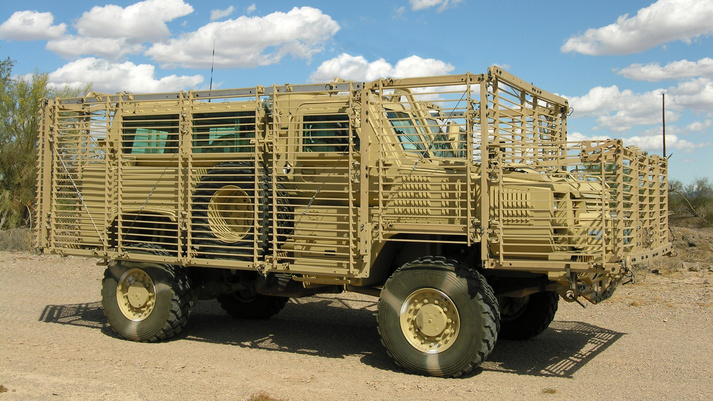
Credit: BAE Systems
BAE Systems has marketed the L-ROD bar armour system since 2009. Made of aluminium, the armour is lightweight while offering the same level of protection from RPGs as afforded by steel bar armour. The modular kit can be configured for any vehicle type. The system can also be installed and maintained in the field with no welding or drilling required. Vitally, hinged doors are set into the armour grid to permit unimpeded egress from the vehicle.
Tank kits
Several preconfigured kits are available which combine various types of add-on armour optimised to support one another, ensuring that no gaps in coverage remain. Users can also choose to apply only selected elements of the kit when the full panoply is not required. One example is the British Army’s theatre entry standard or TES kit, devised for the Challenger 2 MBT and presented to the public in 2016. The primary purpose of the TES is to shield the tank from the threat posed by IEDs and ATGMs. To maximise protection, the kit provides three different add-on solutions, namely ERA, passive appliqué armour, and bar armour. Depending on the tactical situation, the unit can deploy one, two or all three simultaneously.
When fully outfitted, the tank’s organic Dorchester composite armour is augmented by layers of armour blocks along both flanks and the turret (protecting both the crew compartment and ammunition magazine), with bar armour providing further protection, especially at the rear section of the hull and the rear portion of the turret. While useful under any circumstance, the extra protection is especially vital for operations in urban terrain and similarly constrained environments in which close-range ambushes with anti-tank weapons are a possibility.
The Israeli Defense Force’s Merkava MBTs also feature a highly modular all-around set of augmented protection, beginning with the Mk 3 variant, carried over to the current Mk 4 and Mk 4 Barak. The add-on armour is mounted in pre-existing retainers, enabling efficient addition, subtraction, or replacement of armour blocks in the field. This also facilitates keeping the system up to date by easily substituting newly developed materials.
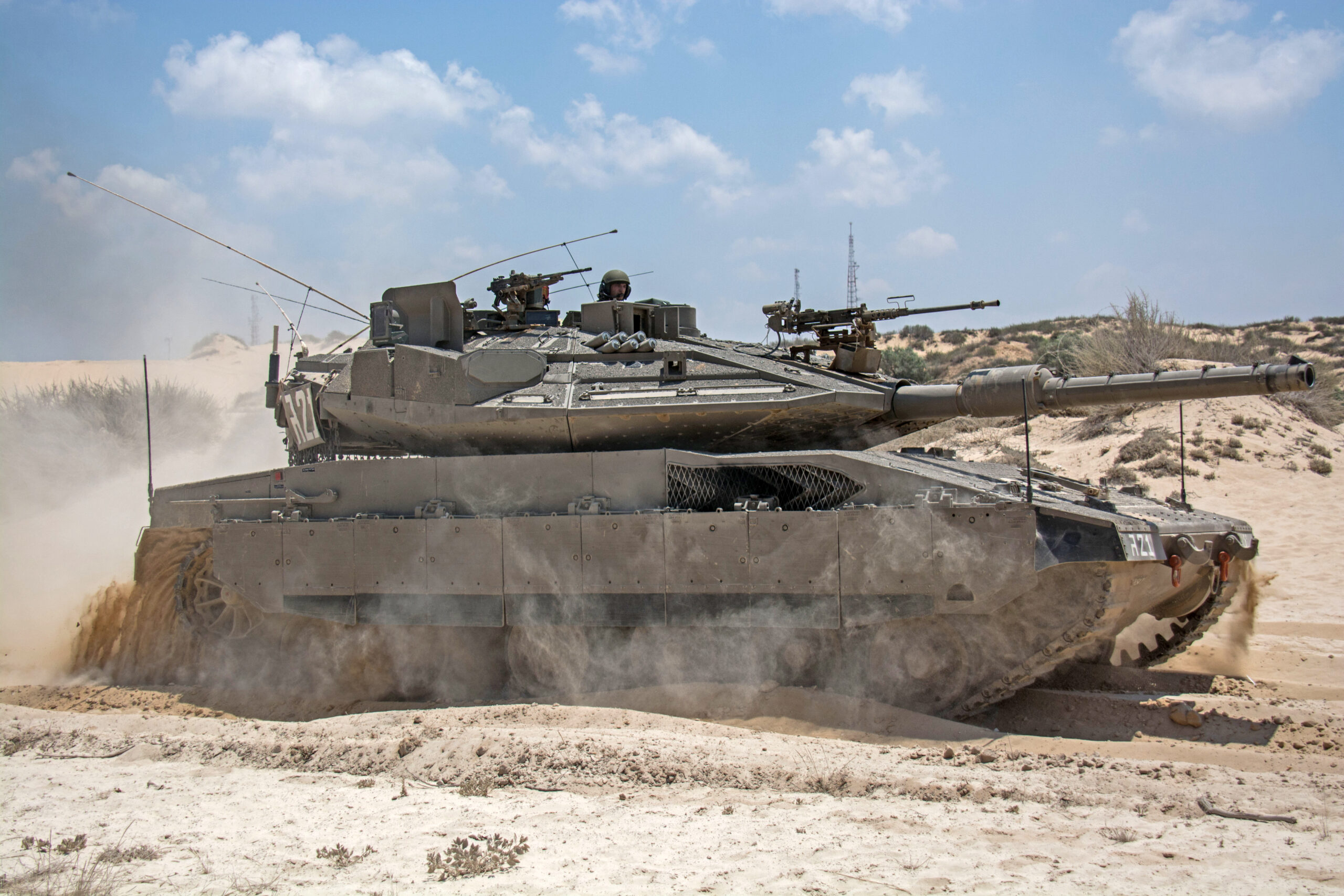
Credit: IDF
The appliqué kit consists primarily of passive ceramic composite armour alongside the chassis and turret (giving the turret a sloped appearance), and also atop the engine compartment and turret. Bar armour augmented by chain-and-ball armour is attached at the (more thinly protected) rear of the tank to detonate warheads before they reach the organic armour. The Merkava Mk 4 is one of the few MBTs which can also be equipped with a modular belly plate to improve protection against IEDs. The V-shaped underbelly module is composed of ceramic composite material. Additionally, low intensity conflict (LIC) or urban warfare configurations of the Merkava are provided with steel mesh around vulnerable points such as sensors, exhaust ports and ventilators to prevent attackers moving from cover to attach explosive charges. Recently, a so-called ‘cope cage’ or overhead bar armour grille has also been observed atop the Merkava turret to defend against top-down attacks.
Future option: electric armour
An alternative concept for countering shaped charges and potential APFSDS rounds is electric armour (also known as electromagnetic reactive armour). It consists of two or more conductive metal plates separated by a non-conductive buffer or a layer of air. One of the plates is kept very highly charged through a supercapacitor, while the other plate serves as the ground path. When a shaped charge jet passes through both plates, it effectively completes the circuit between the charged plate and the ground plate, resulting in a large amount of energy being dumped into the jet at once, disturbing and dispersing the jet in the process of the current moving from charged to ground plate. This effect is also understood to be capable of disturbing APFSDS penetrators, and reducing their penetrative capability, but the extent of this reduction is unclear.
As with ERA, electric armour needs to be coupled with some base passive armour, since the incoming projectile will retain some residual penetrative capability which needs to be absorbed. Electromagnetic armour systems should weigh less than traditional ERA, reducing the burden on the vehicle or enabling protection of lighter weight vehicles such as armoured personnel carriers. The reduced weight is also conducive to covering all vehicle surfaces, affording protection against top-down attacks.
Although several nations, including the US and the UK, have experimented with the concept for nearly two decades, operational electromagnetic reactive armour systems have yet to be introduced as some issues remain. One problem is that commonplace threats such as tandem-HEAT warheads would continue to pose a threat to vehicles using this form of protection. Although the power draw of electric armour has been reported be relatively low, nonetheless, modern vehicles already have large power demands from their mission systems which may reduce the viability of electric armour. As future armoured vehicles with greater onboard energy generation capacity enter service, electric armour may become more operationally viable, providing another option for modular vehicle protection.
Sidney E. Dean and Mark Cazalet






